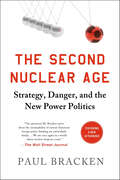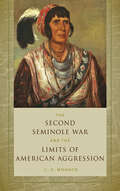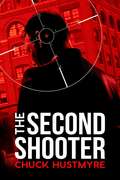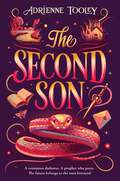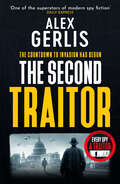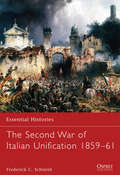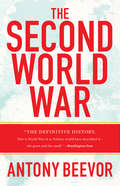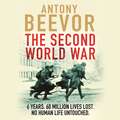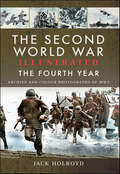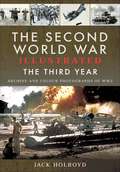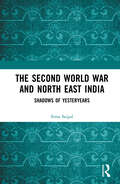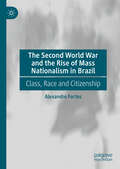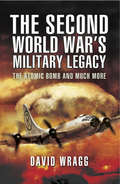- Table View
- List View
The Second Nuclear Age: Strategy, Danger, And The New Power Politics
by Paul BrackenA leading international security strategist offers a compelling new way to "think about the unthinkable." The cold war ended more than two decades ago, and with its end came a reduction in the threat of nuclear weapons―a luxury that we can no longer indulge. It's not just the threat of Iran getting the bomb or North Korea doing something rash; the whole complexion of global power politics is changing because of the reemergence of nuclear weapons as a vital element of statecraft and power politics. In short, we have entered the second nuclear age. In this provocative and agenda-setting book, Paul Bracken of Yale University argues that we need to pay renewed attention to nuclear weapons and how their presence will transform the way crises develop and escalate. He draws on his years of experience analyzing defense strategy to make the case that the United States needs to start thinking seriously about these issues once again, especially as new countries acquire nuclear capabilities. He walks us through war-game scenarios that are all too realistic, to show how nuclear weapons are changing the calculus of power politics, and he offers an incisive tour of the Middle East, South Asia, and East Asia to underscore how the United States must not allow itself to be unprepared for managing such crises. Frank in its tone and farsighted in its analysis, The Second Nuclear Age is the essential guide to the new rules of international politics.
The Second Nuclear Age: Strategy, Danger, and the New Power Politics
by Paul BrackenA leading international security strategist offers a compelling new way to "think about the unthinkable."The cold war ended more than two decades ago, and with its end came a reduction in the threat of nuclear weapons—a luxury that we can no longer indulge. It's not just the threat of Iran getting the bomb or North Korea doing something rash; the whole complexion of global power politics is changing because of the reemergence of nuclear weapons as a vital element of statecraft and power politics. In short, we have entered the second nuclear age.In this provocative and agenda-setting book, Paul Bracken of Yale University argues that we need to pay renewed attention to nuclear weapons and how their presence will transform the way crises develop and escalate. He draws on his years of experience analyzing defense strategy to make the case that the United States needs to start thinking seriously about these issues once again, especially as new countries acquire nuclear capabilities. He walks us through war-game scenarios that are all too realistic, to show how nuclear weapons are changing the calculus of power politics, and he offers an incisive tour of the Middle East, South Asia, and East Asia to underscore how the United States must not allow itself to be unprepared for managing such crises.Frank in its tone and farsighted in its analysis, The Second Nuclear Age is the essential guide to the new rules of international politics.
The Second Objective
by Mark FrostBestselling author Mark Frost makes a triumphant return to fiction with this riveting World War II thriller, based on a shocking real-life German operation run by "the most dangerous man in Europe."Fall 1944. Germany is losing, and the Americans are starting to hope they'll be home for Christmas. Lieutenant Colonel Otto Skorzeny, "Hitler's Commando," famed for his daring rescue of the imprisoned Mussolini, has just received orders for Operation Greif: He is to assemble a new brigade of 2,000 men, all of whom speak English, and send them behind Allied lines disguised as GIs, where they will wreak havoc in advance of a savage new offensive. And from those men, Skorzeny is to select a smaller group, made up of the twenty most highly skilled commandos fluent in American culture, to attempt an even more sinister mission--the second objective--which, if completed, not only would change the course of the war, but would change the course of history.Filled with real characters and details only recently released by the United States military, The Second Objective is historical fiction at its most pulse-pounding, its most unpredictable, and its most compulsively readable.
The Second Seminole War and the Limits of American Aggression
by C. S. MonacoA major study of a costly and influential Jacksonian-era war.The Second Seminole War (1835–1842) was the last major conflict fought on American soil before the Civil War. The early battlefield success of the Seminoles unnerved US generals, who worried it would spark a rebellion among Indians newly displaced by President Andrew Jackson's removal policies. The presence of black warriors among the Seminoles also agitated southerners wary of slave revolt. A lack of decisive victories and a series of bad decisions—among them the capture of Seminole leader Osceola while under the white flag of truce—damaged the US Army's reputation at home and abroad. Desertion was rampant as troops contended with the subtropical Florida wilderness. And losses for the Seminoles were devastating; by the war's end, only a few hundred remained in Florida.In this ambitious study, C. S. Monaco explores the far-reaching repercussions of this bloody, expensive campaign. Taking an interdisciplinary approach, Monaco not only places this protracted conflict within a military context but also engages the various environmental, medical, and social aspects to uncover the war's true significance and complexity.By examining the Second Seminole War through the lenses of race, Jacksonian democracy, media and public opinion, American expansion, and military strategy, Monaco offers an original perspective on a misunderstood and often-neglected chapter in our history.
The Second Shooter
by Chuck HustmyreTwo days before the 50th anniversary of the assassination of President John F. Kennedy, rookie FBI agent Jake Miller is on his way to watch a football game with some friends at RFK Stadium. But Jake has one stop to make first. A quick meeting with a crackpot who called the FBI claiming to know who "really" killed JFK. The caller turns out to be a 70-year-old Frenchman who says he fired the fatal shot from the grassy knoll. Now sure that the man is crazy, Jake is trying to ditch him when four guys in dark suits--real "Men in Black" types--show up to take the old guy into custody. What happens next will turn Jake Miller, the crazy Frenchman, a beautiful FBI intelligence analyst, and a kook conspiracy writer into the targets of a massive federal manhunt--and the only people who can stop another high-profile assassination.
The Second Son (Betrayal Prophecies #2)
by Adrienne TooleyAn epic clash of deities explores the two facets of pain—rage versus sadness—in this rousing followup to The Third Daughter, a dark crown fantasy duology with a sweeping sapphic romance. The centuries-old prophecy has been fulfilled at last: the New Maiden has returned to Velle. Unfortunately, so has a malicious demi-god, whose elusive prophet is intent on converting the New Maiden&’s followers. The Second Son is a vengeful, angry deity, whose psalm resonates with the disenfranchised. With Elodie on the throne and Sabine in her own unique position of power, it should be easy enough to track down the culprit. Yet even as they're falling in love, both girls are keeping dangerous secrets from each other. While the cult of the Second Son threatens to overthrow not only the Church of the New Maiden but also Velle&’s monarchy, Elodie and Sabine must navigate impossible odds to dismantle the root of his power, all while their lives hang in the balance. The Second Son is a must-read for fans of: BookTok Romantasy Red Queen by Victoria Aveyard These Violent Delights by Chloe Gong Friends to Enemies / Betrayal Slow Burn Romance / One Bed
The Second Sun
by P. T. DeutermannA taut, suspenseful historical thriller set in the months of WWII: Did Japan also have an atomic weapon, and did America bomb Hiroshima and Nagasaki to pre-empt an attack on its fleet?A masterful historical thriller set during the waning months of World War II, The Second Sun poses a provocative question: Did Japan test an atomic weapon, and did America know about it in advance of its own decision to drop two nuclear bombs?March 1945: After a career of commanding destroyers in the Pacific theater of WWII, Captain Wolfe Bowen is based in Washington, DC, working for the Chief of Naval Operations. Bowen receives an urgent call from the commander of the naval shipyard in Portsmouth, New Hampshire: A German U-boat has been captured and brought to port. But what grabs Bowen’s attention is the presence of two Japanese civilians on board, along with the massive size of the U-boat itself. What these civilians know about the cargo of the U-boat, as well as its destination, begins a race against time that will change the course of history.When President Franklin Delano Roosevelt dies, Harry Truman ascends to office with no prior knowledge of the Manhattan Project. Bowen is assigned a dangerous mission: Discover whether Japan has the technology to produce an atomic weapon, and find out how close the desperate enemy is to deploying it. Working with a small team—including Captain Villem Amherst Van Rensselaer, part of the inner circle on the Manhattan Project, and Lieutenant Commander Janet Waring, a naval intelligence officer and skilled translator of Japanese—Bowen must report back to President Truman with the information that will transform the war—and the world.Brilliantly imagined and deeply informed by P. T. Deutermann’s long history as a navy captain, as well as his family’s service in the Pacific theater, The Second Sun is a compelling novel timed for the 80th anniversary of the end of World War II.
The Second Traitor (Double Agent series)
by Alex GerlisThe countdown to invasion begins...It's September 1940, and British intelligence is on high alert: the Nazi invasion of Britain is imminent. The German navy is assembling a vast fleet in Rotterdam to ferry men and materiel across the Channel.Meanwhile, a sinister organisation called The Group – a collection of British and Irish Nazi collaborators – is at work within the UK trying to pave the way for the Wehrmacht.The Invasion Warning Sub-Committee is established to counter this threat, and Charles Cooper, coming in from the cold after the disintegration of The Annexe, joins up and is tasked with cracking this nefarious network.But that is not the only concern for the spy chiefs: the search for double agent ‘Archie’ – the Soviet spy and British traitor – is hotting up: they are now confident he works within MI6, and an elaborate scheme is set up to narrow down the list of suspects… To make things worse, they now know for certain that a second traitor, ‘Bertie’, is also in play.With suspicion at paranoia pitch, can MI6 clean house before the Nazis arrive to help them do it?Taking the reader from wartime London to the south coast of England, from Berlin to neutral Ireland and from the German intelligence headquarters in Hamburg to the port of Rotterdam, The Second Traitor is the second novel in Alex Gerlis’s highly acclaimed Double Agent series, a follow-up to Every Spy a Traitor.
The Second War of Italian Unification 1859-61
by Frederick SchneidThe culmination of decades of nationalist aspiration and cynical Realpolitik, the Second War of Italian Unification saw Italy transformed from a patchwork of minor states dominated by the Habsburg Austrians into a unified kingdom under the Piedmontese House of Savoy. Overshadowed by subsequent conflicts, the war saw the first widespread use of railroads in war and the first battlefield deployment of rifled field artillery, as well as the last major battle in world history where all the forces involved were under the personal command of their monarchs. The savage nature of the fighting led to the foundation of the Red Cross and the establishment of the Geneva Conventions, while the colorful uniforms and aggressive doctrine espoused by the French Army in particular were to influence those on both sides of the American Civil War. Beyond the battlefields, the outcome of the war represented a culminating triumph for the Piedmontese prime minister, Camillo di Cavour, whose success in winning and retaining French and British support for his plans for Italian unification has provided a model for the leaders of junior partners allied to world powers ever since. Between April and July 1859 the first stage of the war pitted Napoleon III's French armies and their Piedmontese allies against the Habsburg Austrian forces that had invaded Piedmont. A series of bloody clashes culminating in Solferino-San Martino, the largest battle on European soil since Leipzig in 1813, resulted in decisive defeat for the Austrians and the end of the war in the north. Ten months later the second stage of the war began as the legendary Italian nationalist Giuseppe Garibaldi landed in Sicily with 1,000 volunteers, intent on overthrowing the Bourbon Kingdom of the Two Sicilies. After ejecting the Bourbon forces from Sicily Garibaldi crossed to the mainland and marched on Naples, the capital. The rapid collapse of the Kingdom of the Two Sicilies took everyone by surprise; Cavour feared Garibaldi would capitalize on this victory and march on Rome, but Cavour and Garibaldi agreed to unify their halves of Italy and their respective armies. The remnants of the Bourbon armies finally surrendered in February 1861 and Piedmont's king, Victor Emmanuel, was crowned king of Italy a month later. Unlike many existing accounts, which approach the events of 1859-61 from a predominantly French perspective, this study draws upon a huge breadth of sources to examine the conflict as a critical event in Italian history. A concise explanation of the origins of the war is followed by a wide-ranging survey of the forces deployed and the nature and course of the fighting - on land and at sea - and the consequences for those involved are investigated. This is a groundbreaking study of a conflict that was of critical significance not only for Italian history but also for the development of 19th-century warfare.
The Second World War
by Antony BeevorOver the past two decades, Antony Beevor has established himself as one of the world's premier historians of WWII. His multi-award winning books have included Stalingrad and The Fall of Berlin 1945. Now, in his newest and most ambitious book, he turns his focus to one of the bloodiest and most tragic events of the twentieth century, the Second World War. In this searing narrative that takes us from Hitler's invasion of Poland on September 1st, 1939 to V-J day on August 14th, 1945 and the war's aftermath, Beevor describes the conflict and its global reach--one that included every major power. The result is a dramatic and breathtaking single-volume history that provides a remarkably intimate account of the war that, more than any other, still commands attention and an audience. Thrillingly written and brilliantly researched, Beevor's grand and provocative account is destined to become the definitive work on this complex, tragic, and endlessly fascinating period in world history, and confirms once more that he is a military historian of the first rank.
The Second World War
by Antony BeevorA magisterial, single-volume history of the greatest conflict the world has ever known by our foremost military historian.*****The Second World War began in August 1939 on the edge of Manchuria and ended there exactly six years later with the Soviet invasion of northern China. The war in Europe appeared completely divorced from the war in the Pacific and China, and yet events on opposite sides of the world had profound effects. Using the most up-to-date scholarship and research, Beevor assembles the whole picture in a gripping narrative that extends from the North Atlantic to the South Pacific and from the snowbound steppe to the North African Desert.Although filling the broadest canvas on a heroic scale, Beevor's The Second World War never loses sight of the fate of the ordinary soldiers and civilians whose lives were crushed by the titanic forces unleashed in the most terrible war in history.
The Second World War
by Antony BeevorA magisterial, single-volume history of the greatest conflict the world has ever known by our foremost military historian.The Second World War began in August 1939 on the edge of Manchuria and ended there exactly six years later with the Soviet invasion of northern China. The war in Europe appeared completely divorced from the war in the Pacific and China, and yet events on opposite sides of the world had profound effects. Using the most up-to-date scholarship and research, Beevor assembles the whole picture in a gripping narrative that extends from the North Atlantic to the South Pacific and from the snowbound steppe to the North African Desert.Although filling the broadest canvas on a heroic scale, Beevor's THE SECOND WORLD WAR never loses sight of the fate of the ordinary soldiers and civilians whose lives were crushed by the titanic forces unleashed in this, the most terrible war in history.Read by Sean Barrett(p) 2012 Orion Publishing Group
The Second World War
by John KeeganJohn Keegan's landmark military history of World War II Praised as "the best military historian of our generation" by Tom Clancy, John Keegan here reconsiders his masterful study of World War II, The Second World War, with a new foreword. Keegan examines each theater of the war, focusing on five crucial battles and offering new insights into the distinctive methods and motivations of modern warfare. In eloquent, perceptive analyses of the airborne battle of Crete, the carrier battle of Midway, the tank battle of Falaise, the city battle of Berlin, and the amphibious battle of Okinawa, Keegan illuminates the strategic dilemmas faced by the leaders and the consequences of their decisions on the fighting men and the course of the war as a whole. "Truly magnificent. . . the best military historian of our generation. " -Tom Clancy "Analytical, concise, and coherent. . . if you want to know how it happened, read Keegan's thoughtful and elegant prose. " -Los Angeles Times Book Review "The Second World War merits the acceptance as the standard work that it will surely receive. . . features the eloquence we have come to expect of John Keegan. " -The Washington Post Book World "To write history is to choose, and Mr. Keegan's choices and preferences are as interesting and stimulating as any I have seen. . . Boldly written and fair-minded. " -The New York Times Book Review
The Second World War
by Paul DowswellEpic naval encounters between titanic warships, monumental battles involving thousands of men, and duels between lone snipers facing almost certain death, these are some of the dramatic tales in this collection of true stories from the second world war.
The Second World War Explained
by Michael O'KellyOver seventy years on the terrible events and outcome of the Second World War remains hugely relevant and important. Far from diminishing interest in this truly global conflict is increasing. The internet has enabled detailed research into ancestors war records to an extent unimaginable a decade or so ago.There have been countless thousands of books on all aspects of the War, both general in scope, of particular subjects, biographies and personal memoirs.The author of The Second World War Explained has identified the need for a concise summary covering the main events and personalities. The result is a compelling, highly readable and informing book which allows an understanding of this most dramatic yet tragic period of history. Will appeal to all age groups.
The Second World War Illustrated: 1944: Pushing Back the Axis
by Jack HolroydThe Second World War Illustrated: 1944 follows the author's visual tour of the war by means of painstakingly researched and digitally restored pictures from the period of the key battlefields and events of the period from September 1943 to the late summer of 1944. This year marked a defining change in the balance of the war; by its end the Axis powers were in serious trouble on all their fronts. The book begins with a visual history of the Allied invasion of Italy at Salerno and the subsequent slow progress made in Italy, including the battle for Monte Cassino, the landings at Anzio and the liberation of Rome. The focus then shifts to the planning for the Normandy landings: we are reminded of the magnitude of the task facing the Allies, with an analysis of the formidable defenses of Hitler's Atlantic Wall and the beach defenses along the French coast. There are fascinating pictures of preparations by the Allies during Operation Tiger and detailed maps that explain the build-up and execution of the invasion beaches. There is detailed coverage of the D Day landings and the fierce fighting involved in the breakthrough of the German defenses in Normandy to the liberation of Paris, as well as the often neglected Allied landings in the south of France. The author provides a fascinating photographic history of Operation Valkyrie, the plot to kill Hitler on 20 July 1944, including key players, the planning and the aftermath of the failed attempt on the Führer's life. There is a chapter on Hitler's new terror weapon – the V2 rocket, including the men and women who designed them and the Allied attempts to disrupt their development with the Peenemünde raid; a separate chapter looks at the growing air offensive against Germany. Although overshadowed by events in the west, there is chapter on the increasingly evident collapse of the German army on the Eastern Front, which included the loss of his Army Group Centre. Latter chapters turn our attention to the war in the east. The American advance continued in the South Pacific, involving bloody battles to take what appear to be insignificant islands and island groups, bringing the Allies ever closer to the Japanese mainland. The British and Indian armies continued to be threatened by the Japanese army’s push to India via Burma, which was finally halted at Kohima and Imphal. With over 1,000 original photographs, this is a true labor of love and an ideal purchase for anyone interested in the history of the Second World War in a more accessible form.
The Second World War Illustrated: The First Year: Archive and Colour Photographs of WW2
by Jack HolroydThis fully illustrated history chronicles the road to WWII and the first year of combat through archival and color photographs accompanied by text. The first volume in this series depicts the contributing factors that led to the outbreak of hostilities, including the rise of fascist dictators across Europe and in Japan. It also details the Blitzkrieg invasions that rocked the world as two superpowers, France and Great Britain, were soundly thrashed on the battlefield of Europe. Overwhelmed by the Nazi onslaught, British Expeditionary Force fled across the Channel from Dunkirk, leaving most of their equipment behind. A possible invasion of Kent in the south of England by a triumphant enemy presented a spine-tingling threat to the British people. But Winston Churchill disparaged peace treaties with the Nazi regime, and the fight back began. A few thousand fighter pilots of the Royal Air Force defeated the Luftwaffe by a very narrow margin, and Hitler changed his focus, looking to the east. The first year of the war ended, in September 1940, with Mussolini threatening Egypt and the Suez Canal. Rare wartime photographs capture the drama and humanity of this dark time in Europe.
The Second World War Illustrated: The Fourth Year
by Jack HolroydTHE FOURTH YEAR began with intensified fighting on Guadalcanal in the southern Solomon Islands in September 1942. The United States had launched their fight back in the Pacific when they landed there the previous month. In the Western hemisphere the USA threw its almighty weight into the fight against Hitler’s Germany with the ‘Operation Torch’ landings in North Africa. The Americans had boots on the ground. Hitherto in the war the Axis had largely been the controllers of events; now as often as not, they had to react to occurrences under a continuous rain of blows. Montgomery had masterminded a tactical success at El Alamein in November 1942; Rommel had retreated to face an Allied invasion of Tunisia and defeat of all Axis forces on that continent. This was followed in Russia by Hitler losing an entire army at Stalingrad when the starving survivors surrendered in January 1943. Then the Allies invaded Sicily triggering the ousting of Italy’s dictator, Mussolini, from power. Further concern for the German Führer came with the first daylight bombing raid by the USAAF at the end of January 1943. It was followed by the RAF successfully breaching two dams in the Ruhr valley in a precision night raid. Those events heralded round the clock bombing of Germany by day and night. On the Eastern Front in the summer Hitler gambled one final strategic offensive at Kursk and suffered a decisive defeat, never again to regain the initiative or launch a major offensive in Russia. By the end of the fourth year of the war the Allies dominated the vital Atlantic seaways upon which future Allied strategy was entirely dependent – although the German submarine menace still existed.
The Second World War Illustrated: The Third Year
by Jack HolroydA pictorial history of the third year of World War II, featuring archive and color photographs. This third volume sees Hitler experiencing problems reminiscent of a previous invader of Russia, Napoleon Bonaparte: extreme winter conditions that first drenched then froze the vast Nazi war machine, immobilizing tanks, guns, support vehicles, and grounding the Luftwaffe. Unlike Napoleon, Hitler failed to capture Moscow. In North Africa, the British were sent reeling back towards Egypt when Rommel launched an attack at the end of January. Much to the amazement of all and the disappointment of Churchill—the Axis troops took Tobruk in a single day. Churchill dismissed the commander and appointed Montgomery, who made a stand at El Alamein. Great Britain&’s stand-alone position ended abruptly on when Tojo launched a surprise attack on Pearl Harbor. Both Hitler and Mussolini declared war on the United States and the war became global. With the attack on Pearl Harbor the Japanese flooded through the South Pacific, the Philippines, Dutch East Indies, Malaya, Burma all fell to the Japanese. Once more Great Britain was humiliated when Singapore surrendered and thousands of Allied troops went into captivity. An attempt by the Japanese to deliver a knock-out blow to the Americans by an attack on Midway failed catastrophically and the Americans scored a momentous victory in the Pacific. Air Marshal Sir Arthur Harris became leader of the RAF and the thousand bomber raids and carpet bombing of German cities began. The third year of the war ended with the disastrous Dieppe Raid, carried out by Canadians, in August 1942.Praise for The Second World War Illustrated: The Third Year &“Packed with photographs of machines, battles, weapons, and soldiers. . . . The book is nicely split into separate chapters with each concentrating on a specific event or operation that was being carried out during 1942, so you have the fight for North Africa, the war in the East, Pearl Harbor, Burma, the Bomber Raids over Germany, War in the Pacific and the Commando Raid on St Nazaire etc. . . . Having read the previous book of the previous year I would say it was an equal and would happily recommend it to others, especially if you&’re a younger learner or new to the subject.&” —UK Historian
The Second World War Through Soldiers' Eyes: British Army Life, 1939–1945
by James Goulty'What was it really like to serve in the British Army during the Second World War?Discover a soldier's view of life in the British Army from recruitment and training to the brutal realities of combat. Using first-hand sources, James Goulty reconstructs the experiences of the men and women who made up the 'citizen's army'. Find out about the weapons and equipment they used; the uniforms they wore; how they adjusted to army discipline and faced the challenges of active service overseas.What happened when things went wrong? What were your chances of survival if you were injured in combat or taken prisoner? While they didn't go into combat, thousands of women also served in the British Army with the ATS or as nurses. What were their wartime lives like? And, when the war had finally ended, how did newly demobilised soldiers and servicewomen cope with returning home?The British Army that emerged victorious in 1945 was vastly different from the poorly funded force of 865,000 men who heard Neville Chamberlain declare war in 1939. With an influx of civilian volunteers and conscripts, the army became a citizens force and its character and size were transformed. By D-Day Britain had a well-equipped, disciplined army of over three million men and women and during the war they served in a diverse range of places across the world. This book uncovers some of their stories and gives a fascinating insight into the realities of army life in wartime.
The Second World War Volume I
by Henri Michel“The best available history of the subject” is how the Times Literary Supplement (London) described the original French edition of this book. And Professor Michel, as President of the International Historical Committee for the Second World War and for the past twenty years Secretary-General of the French Historical Committee for the Second World War, was certainly uniquely qualified to produce the authoritative work on the second “war to end all wars.” The Second World War was an unprecedented event. Starting as a European conflict on the established pattern, it eventually became the first war to involve every continent and, in the case of the Pacific, war between continents. The use of air and sea power and the advance of technology made it the first conflict in which civilians were in the front line, and in which the distinction between combatants and noncombatants was almost erased. To a hitherto unknown degree it was also an economic struggle, decided in the end not by individual or collective skill or valor but by the balance of resources available to the participants. The last factor is most clearly evident in the long-term consequences of the war. As Professor Michel demonstrates, it is now clear that the Second World War was the swan song of the European hegemony. Europe, for centuries the begetter of nations and the master of empires, entered the conflict with the trappings, if not the substance, of world leadership. In 1945, however, it was clear that the victory had been won by the resources and manpower of the United States and the Soviet Union, and that the age of the superpowers had dawned. The nations of Europe were physically battered and economically crippled. They had lost their place in the front rank; their empires were doomed; their political and economic power destroyed. Moreover, the two superpowers were now directly involved in European affairs and would henceforth hold the whip hand in deciding the outcome of European conflicts. Professor Michel’s handling of his vast subject and its themes is masterly. The narrative is fluent and lucid, the analysis clear and brilliantly argued. He does full justice to the subject and leaves the reader with an understanding of an immensely comple perio that is in itself a tribute to the author’s skill. The Second World War is amply supplemented with maps, a comprehensive bibliography, and an index, and the translation by Douglas Parmee of Queens’ College, Cambridge University, renders with admirable clarity the original’s mastery of style and subject.
The Second World War Volume II
by Henri Michel“The best available history of the subject” is how the Times Literary Supplement (London) described the original French edition of this book. And Professor Michel, as President of the International Historical Committee for the Second World War and for the past twenty years Secretary-General of the French Historical Committee for the Second World War, was certainly uniquely qualified to produce the authoritative work on the second “war to end all wars.” The Second World War was an unprecedented event. Starting as a European conflict on the established pattern, it eventually became the first war to involve every continent and, in the case of the Pacific, war between continents. The use of air and sea power and the advance of technology made it the first conflict in which civilians were in the front line, and in which the distinction between combatants and noncombatants was almost erased. To a hitherto unknown degree it was also an economic struggle, decided in the end not by individual or collective skill or valor but by the balance of resources available to the participants. The last factor is most clearly evident in the long-term consequences of the war. As Professor Michel demonstrates, it is now clear that the Second World War was the swan song of the European hegemony. Europe, for centuries the begetter of nations and the master of empires, entered the conflict with the trappings, if not the substance, of world leadership. In 1945, however, it was clear that the victory had been won by the resources and manpower of the United States and the Soviet Union, and that the age of the superpowers had dawned. The nations of Europe were physically battered and economically crippled. They had lost their place in the front rank; their empires were doomed; their political and economic power destroyed. Moreover, the two superpowers were now directly involved in European affairs and would henceforth hold the whip hand in deciding the outcome of European conflicts. Professor Michel’s handling of his vast subject and its themes is masterly. The narrative is fluent and lucid, the analysis clear and brilliantly argued. He does full justice to the subject and leaves the reader with an understanding of an immensely complex period that is in itself a tribute to the author’s skill. The Second World War is amply supplemented with maps, a comprehensive bibliography, and an index, and the translation by Douglas Parmee of Queens’ College, Cambridge University, renders with admirable clarity the original’s mastery of style and subject.
The Second World War and North East India: Shadows of Yesteryears
by Sima SaigalThis book discusses the untold story of North East India’s role during the Second World War and its resultant socio-economic and political impact. It goes beyond standard campaign histories and the epicentre of the Kohima-Imphal battlefields to the Brahmaputra and Surma Valley of Assam—the administrative and political hub of the region, where decisions on the allied war efforts were deliberated and effected right from the outset of the War. What happened in the entire region during the intervening years from 1939? What did the war mean for the people of Assam? How were resources from the region mobilized for the global war effort and how did people adapt, co-opt and survive during these tumultuous years? What was the response of the nationalist and provincial political leaders to the challenges and demands of war? How did the crisis of the 1942 war impact the region? First of its kind, this book investigates hitherto unanswered questions to offer an understanding of contemporary Assam and the North East, including discussions on the complexity of issues such as terrain, migration, taxation, profiteering, inflation, famine and food grain trade. With its lucid style and rich archival material, this volume will be essential for scholars and researchers of history, the Second World War, South Asian history, politics and international relations, colonial studies, sociology and social anthropology, and North East India studies as well as to the interested general reader.
The Second World War and the Rise of Mass Nationalism in Brazil: Class, Race and Citizenship
by Alexandre FortesThis book reexamines the socioeconomic and political transformation that occurred in Brazil during the 1940s as a result of the Second World War. Integrating social and political history, the author explores the adoption of new policies around state-sponsored industrialisation, the consolidation of Brazilian labour law institutions, and the expanded influence of ‘racial democracy’ in the country's domestic and foreign policy. The book argues that the nature of the Brazilian state and its definitions of citizenship were redefined both from ‘the top’ – as a result of Brazil’s integration in the new international order following the War – and ‘from below’ - as antifascism and mass nationalism opened new spaces for subaltern agency. Challenging traditional narratives on Brazil’s transition from the Estado Novo dictatorship of Getúlio Vargas to a postwar democratic experience, this book highlights the extent to which political developments were shaped by key global processes and foreign relations with the USA. The book also focuses on the ‘bottom-up’ forces and actors that brought about change in Brazil, emphasising the role of workers, protestors, and popular actors in shaping history. Breaking new ground in Brazilian historiography, this book makes a significant contribution to studies of populism and democratisation in Latin America.
The Second World War's Military Legacy: The Atomic Bomb and Much More
by David Wragg'Necessity is the mother of invention' and nothing is more necessary than victory in war. Driven by the need to defeat Hitler's Nazis and Japanese Imperial ambitions, the period 1939 1945 saw huge and unprecedented leaps in the invention and development of war winning weapons and technology.Well=known author and military expert David Wragg has studied the whole range of land, sea and air technical innovations that originated during the Second World War. Most obvious and strategically important is the Atomic Bomb (and its successor the Hydrogen Bomb) but the list is truly fascinating cruise and ballistic missiles, landing craft, self-propelled guns assault ships, IFF (identification friend or foe), jet engines, sonar, ejection seats to name but some.A number of inventions, while important at the time, had no longer term use; for instance dive-bombers. Others were available but not used until post-war such as in-flight refuelling.The author concludes from his extensive research arguing that there is little new in defence today as so many modern weapons trace their origins back to the Second World War.This is an original and thought-provoking book by a highly respected military history author.

